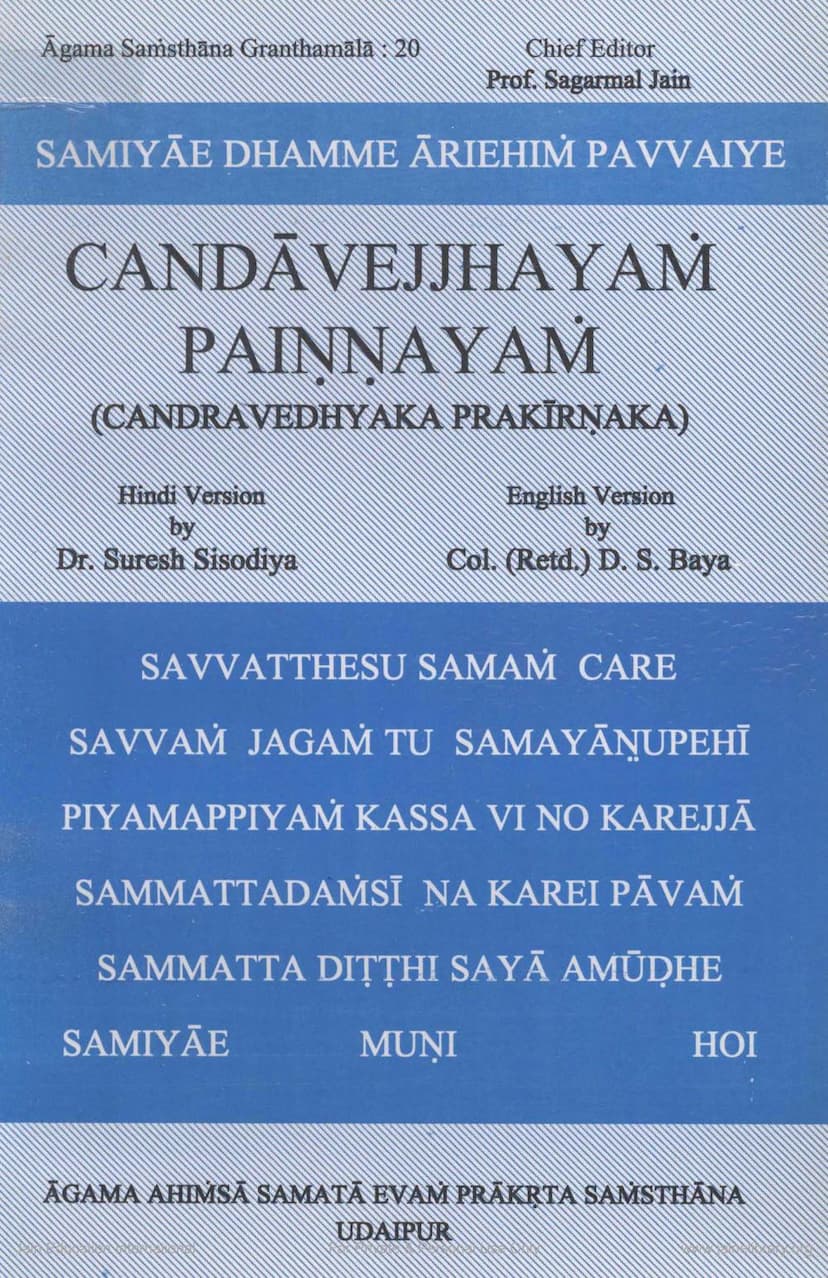Agam 30 Prakirnak 07 Candavejjhayam Sutra
Added to library: September 1, 2025

Summary
Here's a comprehensive summary of the provided Jain text, "Agam 30 Prakirnak 07 Candavejjhayam Sutra," authored by D.S. Baya and published by Agama Ahimsa Samta Evam Prakrit Samsthan:
Book Title: Agam 30 Prakirnak 07 Candavejjhayam Sutra (Candravedhyaka Prakirņaka)
Author(s): Colonel (Retd.) D.S. Baya (English Transliteration and Translation), Dr. Suresh Sisodiya (Hindi Version)
Publisher: Agama Ahimsa Samata Evam Prākrta Samsthana, Udaipur
Overall Purpose: This publication presents the English transliteration and translation of the Candravedhyaka Prakirņaka, a significant text within the Prakīrņaka category of Jain canonical literature. The aim is to make this ancient and spiritually rich work accessible to an English-speaking audience.
Key Aspects and Content:
- Introduction to Jain Agamas: The preface highlights the importance of the Agamas in Jainism, drawing parallels to scriptures in other major religions. It clarifies that Jain Agamas are compilations of teachings from enlightened beings (Arhatas and saints), not divine revelations.
- Linguistic Evolution of Jain Canons: The text explains the division of Jain canonical literature into Ardhamāgadhi and Sauraseni canons, with Ardhamāgadhi being more ancient and closer to Lord Mahāvīra's original language.
- Classification of Canonical Texts: The preface details the traditional classification of Jain texts, including Angapraviştha (primary canons) and Angabāhya (secondary canons), and further subdivisions within Angabāhya like Āvaśyaka and Āvaśyakavyatirikta. Candravedhyaka is identified as an Angabāhya, Āvaśyakavyatirikta, and Utkālika (all-time studiable) scripture.
- The Prakīrņakas: The work discusses the nature of Prakīrņakas as collections of miscellaneous spiritual subjects, traditionally believed to have been composed by individual monks. It lists ten recognized Prakīrņakas, including Candravedhyaka.
- About Candravedhyaka:
- Meaning of the Name: The name "Candravedhyaka" is interpreted as "piercing the eyeball of the mechanically rotating statuette (Rādhāvedha)." This metaphor signifies achieving the ultimate goal of life through voluntary peaceful death (Samādhi Marana).
- Authorship and Period: The author and precise period of composition for Candravedhyaka are unknown. However, its mention in texts like Nandīsūtra and Pākṣikasūtra (dating back to around the 5th Century AD or earlier) indicates its antiquity. Comparative linguistic analysis suggests a composition period contemporary with works like Tattvärtha Bhāṣya and Prasamarati Prakaraṇa (1st-3rd Century AD).
- Subject Matter: The text is a treatise in verse that prescribes the code of conduct for aspirants pursuing Samādhimaraṇa. It is structured into seven "doors" (sections) covering:
- Humility (Vinaya Guna): Emphasizes that a disciple's greatness lies in humility, not just knowledge. It highlights the importance of respecting teachers and warns against pride.
- Qualities of a Master (Ācārya Guņa): Describes the ideal qualities of a Jain spiritual teacher, such as patience, stability, tolerance, and profound knowledge of scriptures and principles.
- Qualities of a Disciple (Śişya Guņa): Outlines the virtues expected of a disciple, including humility, endurance, contentment, obedience, and dedication to learning.
- Ethical Code of Conduct (Vinaya Nigraha Guņa): Focuses on the adherence to conduct rules as a pathway to spiritual liberation. It stresses the importance of humility and righteousness in conquering passions and achieving spiritual goals.
- Righteousness of Knowledge (Jñāna Guņa): Discusses the interplay between knowledge and conduct, asserting that true knowledge must be translated into practice. It emphasizes that knowledge is essential for detachment and liberation.
- Fundamentals of Right Conduct (Cāritra Guna): Details the practices of right conduct, including adherence to vows, self-control, and the primacy of right faith (Samyagdarśana) over right conduct.
- Fundamentals of Voluntary Peaceful Death (Samādhi Marana Guņa): This section deals with the noble practice of voluntary death, stressing detachment, mental equanimity, and the importance of spiritual training to face death peacefully and achieve liberation. It uses the metaphor of "Candravedhyaka" to signify reaching the ultimate goal.
- Comparative Study: The appendix provides a comparative study of verses from Candravedhyaka with verses found in other canonical texts, Niryuktis, and Prakīrņakas, demonstrating the interconnectedness and shared philosophical underpinnings within Jain literature.
- Translational Effort: Colonel (Retd.) D.S. Baya expresses the significance of this maiden effort to translate a Prakīrņaka into English, acknowledging the challenges of translating ancient Prakrit into modern English. He is indebted to the Hindi version by Dr. Suresh Sisodiya and Prof. Sagarmal Jain.
- Publisher's Note: The publisher emphasizes the value of Jain Agamic literature and the importance of making these texts accessible through translations, particularly for the Western audience. They acknowledge the contributions of various scholars and patrons, including Śrī Sunderlalji Dugar for financial support.
- Monetary Assistance: The text highlights the generous contribution of Sri Sunderlalji Dugar, praising his philanthropic and religious contributions.
Core Teachings and Themes:
- Humility and Respect: The text strongly advocates for humility and reverence towards teachers as fundamental virtues for spiritual growth.
- The Indispensability of Conduct: While knowledge is important, the practical application of that knowledge through right conduct is paramount for liberation.
- Detachment and Renunciation: A recurring theme is the necessity of renouncing worldly attachments and desires to achieve spiritual goals.
- Voluntary Peaceful Death (Samādhi Marana): The text elucidates the spiritual significance and preparation required for Samādhi Marana, presenting it as an advanced stage of spiritual attainment.
- Interconnectedness of Knowledge, Belief, and Conduct: The work highlights that these three elements are interdependent and crucial for spiritual progress, with faith often given primacy.
In essence, the Candravedhyaka Prakirņaka is a profound Jain scripture that guides spiritual aspirants on the path of self-realization, emphasizing the cultivation of virtues like humility, obedience, knowledge, and disciplined conduct, culminating in the noble aspiration of achieving liberation through a peacefully embraced death. This English translation by Col. D.S. Baya makes this valuable text available to a wider audience, contributing to the dissemination of Jain wisdom.